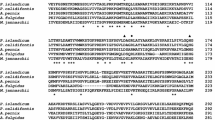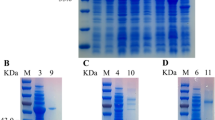Abstract
A thermostable l-malate dehydrogenase from the hyperthermophilic sulfate-reducing archaeon Archaeoglobus fulgidus was isolated and characterized, and its gene was cloned and sequenced. The enzyme is a homodimer with a molecular mass of 70 kDa and catalyzes preferentially the reduction of oxaloacetic acid with NADH. A. fulgidus l-malate dehydrogenase was stable for 5 h at 90° C, and the half-life at 101° C was 80 min. Thus, A. fulgidus l-malate dehydrogenase is the most thermostable l-malate dehydrogenase characterized to date. Addition of K2HPO4 (1 M) increased the thermal stability by 40%. The primary structure shows a high similarity to l-lactate dehydrogenase from Thermotoga maritima and gram-positive bacteria, and to l-malate dehydrogenase from the archaeon Haloarcula marismortui and other l-lactate-dehydrogenase-like l-malate dehydrogenases.
Similar content being viewed by others
Author information
Authors and Affiliations
Additional information
Received: 20 November 1997 / Accepted: 28 February 1997
Rights and permissions
About this article
Cite this article
Langelandsvik, A., Steen, I., Birkeland, NK. et al. Properties and primary structure of a thermostable l-malate dehydrogenase from Archaeoglobus fulgidus. Arch Microbiol 168, 59–67 (1997). https://doi.org/10.1007/s002030050470
Issue Date:
DOI: https://doi.org/10.1007/s002030050470




